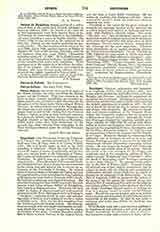

Peuerbach (also PEURBACH, PURBACH, PURBACHIUS), GEORGE VON, Austrian astronomer, b. at Peuerbach near Linz, May 30, 1423; d. in Vienna, April 8, 1461. His real family name, as well as his early schooling, is unknown. About the year 1440 he received the degree of master of philosophy and the free arts, cum insigni laude, at the University of Vienna. His teacher in mathematics was probably Johann von Gmunden. In 1448 he went on a trip to Italy for the sake of study. There Bianchini of Ferrara and Cardinal Nicholas of Cusa, then in Rome, became interested in the young man and induced him to lecture on astronomy at the University of Ferrara. He refused offers of professorships at Bologna and Padua, and also the appointment as court astronomer to King Ladislaus of Hungary, but went back to Vienna in 1450 to teach. He lectured on philology and classical literature. His scientific teaching was done chiefly in private, his most famous pupil being Johann Muller of Konigsberg, later known as Regiomontanus. Peuerbach has been called the father of observational and mathematical astronomy in the West. He began to work up Ptolemy’s “Almagest”, replacing chords by sines, and calculating tables of sines for every minute of arc for a radius of 600,000 units. This was the first transition from the duodecimal to the decimal system. His observations were made with very simple instruments, an ordinary plumb line being used for measuring the angles of elevation of the stars. Cardinal Bessarion invited him to Rome to study Ptolemy in the original Greek and not from a faulty Latin translation. He accepted on condition that Muller go with him. On account of the master’s death the pupil went alone to complete the work.
Peuerbach is also noted for his great attempt to reconcile the opposing theories of the universe, the so-called homocentric spheres of Eudoxus and Aristotle, with Ptolemy’s epicyclic trains. This work, “Theoricie, etc.”, had an enormous success and remained the basis of academic instruction in astronomy until years after Copernicus had swept away all these hypotheses. Twenty works are known. Among these the following are the most important: “Theorice novae planetarum, id est septem errantium siderum nee non octavi seu firmaments” (Ist ed., Nuremberg, 1460, followed by many others in Milan and Ingolstadt); “Sex primi libri epitomatis Almagesti”, completed by Regiomontanus (Venice, 1496; Basle, 1534; Nuremberg, 1550); “Tabula eclypsium super meridiano Viennensi” (2nd ed., Vienna, 1514); “Quadratum geometricum meridiano” (Nuremberg, 1516); “Nova tabula sinus de decem minutis in decem per multas, etc.”, completed by Regiomontanus (Nuremberg, 1541).
WILLIAM FOX

